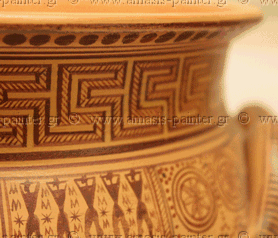Hellenic Pottery Painting
in Historical Times
|
A. Place in Land
Characteristic of all great civilizations is that even their insignificant works reflect the greatness of their time. This is also the case with ancient Hellenic pottery. Whether objects of sacred functions, elements of burial customs or vessels of everyday use, they mirror the spirit of their time often through an art of especially high aesthetic value. The characteristics of this art are mainly the following: The emergence and perfection of the shape often in absolute connection with its use (kraters for wine, arybals and alabasters for the bath, etc.) and also the matching of the decoration to the shape of the vessel, Additionally, there is a special relation between the use and the way figures and the secondary patterns are developed. However, this relationship is not always straight or obvious — mainly during its evolution from the primary burial use of the first geometric kraters to the subsequent additional secular and commercial use of the object. It must be made clear that the secular and worship uses of the vessels were not separate. Objects in antiquity had a different specific gravity and life held unity. Children were buried in wine amphoras while on the other hand, household objects were richly painted. There was also no separation between handicraft and the “great art” (the Greek language, which is so rich, did not invent a separate word). The value of the object remains incorporated in its transgressional dimension. We are in a time when identity and social bonds are accomplished with verbal tradition through memory and communicational function of the early pictorial art perhaps overwhelms the apparent importance of the ceramic production.(*)
(*) Ancient pottery, like icons and holy utensils of the Byzantine times as well as the television of our time perform a communicative role. Meanings are abridged, social symbols are ciphered, common representation is materialized and language becomes an instrument for the interpretation and acceptance of reality in each era - the way we perceive ourselves, the environment and other people by reproducing them. All these, of course, concern scholars since vessels are, mainly, everyday objects that perfectly combine the use value with the artistic form.
![]()
HAND MADE AND PAINTED IN GREECE






